Traditional control methods of two-wheeled robot are usually model-based and require the robot’s precise mathematic model which is hard to get. A sensorimotor self-learning model named SMM TWR is presented in this paper to handle these problems. The model consists of seven elements: the discrete learning time set, the sensory state set, the motion set, the sensorimotor mapping, the state orientation unit, the learning mechanism and the model’s entropy. The learning mechanism for SMM TWR is designed based on the theory of operant conditioning (OC), and it adjusts the sensorimotor mapping at every learning step. This helps the robot to choose motions. The leaning direction of the mechanism is decided by the state orientation unit. Simulation results show that with the sensorimotor model designed, the robot is endowed the abilities of self-learning and self-organizing, and it can learn the skills to keep itself balance through interacting with the environment.

